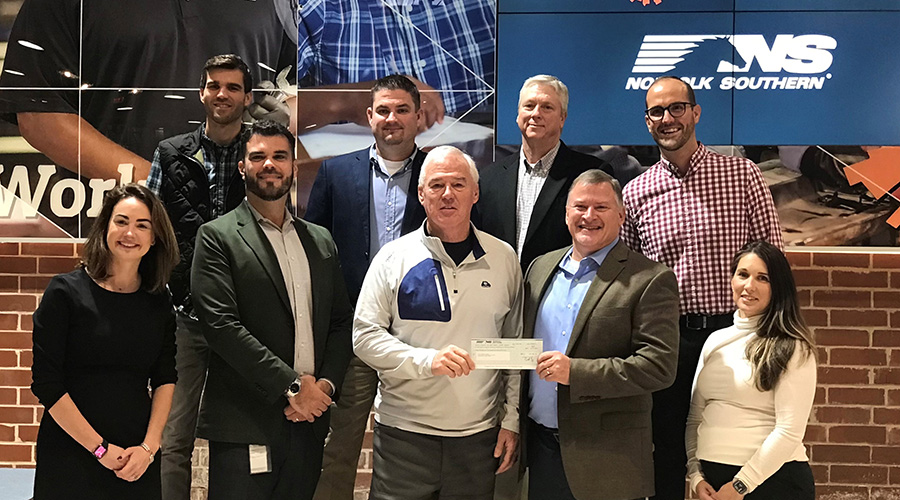Analysis: Why the STB’s ruling on Amtrak’s Gulf Coast case matters
2/28/2022
By Julie Sneider, Senior Associate Editor
The Surface Transportation Board’s (STB) review of Amtrak’s petition to relaunch Gulf Coast service kicked into high gear earlier this month, as board members spent two days listening to public opinions on the national intercity passenger railroad's plans.
Amtrak — which wants to run two daily round-trips between New Orleans and Mobile, Alabama — has appealed to the STB to require CSX and Norfolk Southern Railway to allow Amtrak trains to use the Class Is’ Gulf Coast infrastructure. Amtrak trains haven't operated along the coast since Hurricane Katrina struck in 2005.
The case has ramifications for passenger-rail service beyond the Gulf Coast. Amtrak petitioned the STB after its discussions with CSX and NS ended in a stalemate over a number of points, including the cost of rail infrastructure work that’s necessary to accommodate more trains. Their conversations about reintroducing Gulf Coast service date back at least to 2015.
The STB has scheduled several days for testimony and presentations in the case: Feb. 15-16 was set for receiving public input and holding a pre-evidentiary hearing. The evidentiary hearing was initially scheduled to begin March 9, but CSX on Feb. 23 filed a motion to postpone the proceedings until the first week in April.
Whose train goes first?
Testimony presented at the Feb. 15-16 public hearing underscores why the STB’s ruling will determine the future of U.S. passenger-rail service. At issue: Whose trains have priority in the nation’s rail corridors — Amtrak’s or the host freight railroads that own most track outside the Northeast Corridor?
 “Congress established a preference for passenger-rail operations over host railroad lines, and the presumption is that passenger service will, in fact, operate.” — Amit Bose, FRA administrator Federal Railroad Administration
“Congress established a preference for passenger-rail operations over host railroad lines, and the presumption is that passenger service will, in fact, operate.” — Amit Bose, FRA administrator Federal Railroad Administration The question dates to 1970, when Congress passed the Railroad Passenger Act that created Amtrak. Although the legislation relieved the financially struggling private railroads of their “common carrier obligation” to provide intercity passenger rail service, it also required them to host Amtrak trains on their track.
But when freight-rail volume on a particular route is heavy and growing, whose trains have preference: Amtrak’s or the host’s? The STB’s response will be as important to CSX, NS and the freight-rail industry as it is to Amtrak.
Amtrak wants the issue clarified for many reasons. Among them: It will help Amtrak improve its on-time performance; and it will enable the railroad to expand passenger-rail service to parts of the country that want it but don’t have it, or at least enough of it.
In representing the U.S. Department of Transportation’s (USDOT) perspective, Federal Railroad Administrator Amit Bose testified to the case’s significance. The ruling’s timing is especially critical now that the Infrastructure Investment and Jobs Act (IIJA), which Congress passed late last year, provides an unprecedented level of federal funding for establishing and expanding passenger-rail service throughout the country.
The law’s “expansive vision for intercity passenger rail development rests largely on the ability to introduce, improve and restore passenger-rail services that operate over host railroads,” Bose told the STB. “Without that ability, Congress’s vision cannot become reality.”
Bose asked the STB to establish a framework for future cases that embodies Congress’s original intent in the Amtrak law, as well as encourage greater cooperation between Amtrak and host railroads in the future.
A host railroad’s claim that passenger service would unreasonably impair freight-rail service must be “a meaningful one” under the federal statute, Bose said. In this case, it’s the USDOT’s position that CSX and NS have not met that standard, Bose said. Congress didn’t intend for Amtrak to have to “accommodate” freight-rail operations, he added.
“Congress established a preference for passenger-rail operations over host railroad lines, and the presumption is that passenger service will, in fact, operate,” said Bose.
Amtrak’s proposed addition of two daily round trips between New Orleans and Mobile illustrates this point, Bose explained.
“The board’s decision should ensure that freight railroads cannot effectively ‘crowd out’ passenger service by claiming that it conflicts with their existing or planned railroad operations,” he said.
Bose emphasized that USDOT appreciates freight railroads’ importance to the nation’s supply chain. To that end, if the STB grants Amtrak’s request to operate the Gulf Coast route, the FRA would closely monitor the service and address any challenges that arise.
“The board’s decision [in this case] will have far-reaching implications beyond the Gulf Coast,” Bose told the STB. “The outcome of this proceeding will be pivotal to the future development of intercity passenger rail in this country.”
Amtrak President and CEO Stephen Gardner concurred.
Even though the private railroads “eagerly embraced their bargain” with Congress under the Railroad Passenger Act of 1970, they have not always lived up to their end of that deal, Gardner told the STB. And that has to change, he argued. Amtrak’s network map has remained largely unchanged for 50 years. Now that the railroad has access to historic levels of federal funding, it has the opportunity to bring passenger-rail service to dozens of new communities.
Currently, Amtrak — along with its 17 state partners — serves 46 states. Amtrak’s proposed Connect US expansion plan calls for improving 25 existing routes, adding 39 new routes and bringing service to over 160 new communities. That’s on top of the 525 communities the railroad now serves.
The STB ruling will determine how smoothly Amtrak will pursue its Connect US in markets hungry for passenger-rail service, Gardner said. [Mayors of cities in some of those proposed corridors made a similar point when they testified before the STB.]
“It is not for CSX and NS to determine that Norfolk may have Amtrak service but Mobile and Mississippi should be left behind,” Gardner said.
Freight railroads: The economy depends on us
But to CSX and NS, Amtrak’s proposed expansion plan is exactly why the STB needs to carefully weigh how additional passenger trains could interfere with local and national commerce. Port of Mobile and Alabama state officials, along with the Alabama’s congressional delegation, all stated their concerns that Amtrak trains on the Gulf Coast would negatively affect the timely movement of freight trains in the region.
 “This case is about far more than just getting 20 to 40 people per trip from New Orleans to Mobile.” — James Foote, CSX president and CEO CSX
“This case is about far more than just getting 20 to 40 people per trip from New Orleans to Mobile.” — James Foote, CSX president and CEO CSX And while they didn’t take a side on the Amtrak Gulf Coast matter, Association of American Railroads and American Short Line and Regional Railroad Association (ASLRRA) leaders implored the board to consider the impact Amtrak’s expansion could have on freight-rail traffic.
“Freight rail operations should not be negatively impacted by the re-establishment of Gulf Coast passenger service, nor should a precedent be set that would result in freight rail operations being harmed in other places throughout the country as passenger rail grows over the next decade and beyond,” testified ASLRRA President Chuck Baker. “If the precedent is set that passenger rail service can be expanded without thoroughly assessing and managing the impacts to freight rail on the freight railroad’s owned infrastructure, the fluidity and efficiency of our national freight rail system will be harmed.”
In his comments during the STB hearing, CSX President and CEO James Foote emphasized his railroad is not opposed to passenger-rail service, including along the Gulf Coast. But it must be achieved through a partnership in which all interests are addressed, he said.
“This case is about far more than just getting 20 to 40 people per trip from New Orleans to Mobile,” Foote said. “It’s about a new, national agenda and Amtrak’s desire to change the law and create a new road map for imposing new passenger service without working with host carriers or local communities to first add necessary capacity. It is hard to resolve a dispute when the other side has a different agenda.”
On Feb. 24 CSX and NS jointly filed additional comments with the STB that further illustrate their concern about the impact on rail traffic without Amtrak first investing in freight-rail infrastructure improvements along the route.
“Amtrak has stood firm in its position that not a single penny of additional rail infrastructure is necessary to support the proposed Gulf Coast passenger service and avoid harm to freight service,” the Class Is’ filing states. “The only investments Amtrak has committed to making prior to the commencement of Gulf Coast passenger service are for passenger station upgrades. Amtrak does not even plan to first construct a dedicated layover track at the Mobile station location, a project that every stakeholder agrees is critical, including FRA.”
CSX and NS also cite a rail traffic controller study they completed in 2021 that established Gulf Coast passenger-rail service “will cause immediate and significant harm to freight service without infrastructure investments.” The study found that the introduction of passenger trains in 2019 without additional infrastructure would increase freight delays by 22.7%, reduce trains speeds by 4.5%, increase dispatching conflicts by 38.1%, increase recrews by 37.7% and increase service variability.
Viewing the case from both sides
One person with a unique perspective on the Amtrak Gulf Coast case is Wick Moorman, who served as NS president and CEO from 2005 to 2015, then a year after he retired from NS served a 16-month stint as Amtrak’s CEO. Moorman told the STB that track-sharing agreements between Class Is and Amtrak can benefit both sides if the parties involved are open to transparency and collaboration. When he was NS CEO, the Class I reached agreements with Amtrak, Virginia and North Carolina that resulted in a significant expansion of Amtrak service in those states, Moorman told the STB.
"I felt then, and I still feel now, that these agreements were a win-win for Norfolk Southern, Amtrak and the people who live in Virginia and North Carolina," he said. "The Amtrak services have been very successful, attracting high ridership leading to additional service increases. And, very importantly, there has been significant public investment in Norfolk Southern's rail lines as a result of the Amtrak services."
He found that once states see the benefits of passenger rail, “they can’t get enough of it,” he said.
That’s why it’s important for the STB to help all sides resolve the conflict over Amtrak’s proposed Gulf Coast service: There is a demand, need and bipartisan support for more passenger-rail service in the United States, particularly across the South, Moorman said.
That can occur even as freight-rail volumes increase, as long as all sides are willing to negotiate and cooperate, he added.
Perhaps that’s a perspective both sides should consider in the coming weeks, as they prepare their evidence for the next STB hearing.



